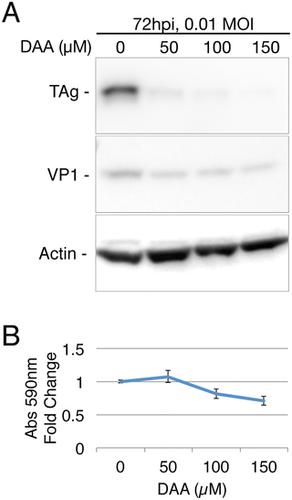PLoS Pathogens ( IF 5.5 ) Pub Date : 2018-02-15 , DOI: 10.1371/journal.ppat.1006919 Kevin Tsai 1 , David G Courtney 1 , Bryan R Cullen 1

|
Polyomaviruses are a family of small DNA tumor viruses that includes several pathogenic human members, including Merkel cell polyomavirus, BK virus and JC virus. As is characteristic of DNA tumor viruses, gene expression in polyomaviruses is temporally regulated into an early phase, consisting of the viral regulatory proteins, and a late phase, consisting of the viral structural proteins. Previously, the late transcripts expressed by the prototypic polyomavirus simian virus 40 (SV40) were reported to contain several adenosines bearing methyl groups at the N6 position (m6A), although the precise location of these m6A residues, and their phenotypic effects, have not been investigated. Here, we first demonstrate that overexpression of the key m6A reader protein YTHDF2 induces more rapid viral replication, and larger viral plaques, in SV40 infected BSC40 cells, while mutational inactivation of the endogenous YTHDF2 gene, or the m6A methyltransferase METTL3, has the opposite effect, thus suggesting a positive role for m6A in the regulation of SV40 gene expression. To directly test this hypothesis, we mapped sites of m6A addition on SV40 transcripts and identified two m6A sites on the viral early transcripts and eleven m6A sites on the late mRNAs. Using synonymous mutations, we inactivated the majority of the m6A sites on the SV40 late mRNAs and observed that the resultant viral mutant replicated more slowly than wild type SV40. Alternative splicing of SV40 late mRNAs was unaffected by the reduction in m6A residues and our data instead suggest that m6A enhances the translation of viral late transcripts. Together, these data argue that the addition of m6A residues to the late transcripts encoded by SV40 plays an important role in enhancing viral gene expression and, hence, replication.
中文翻译:

在 SV40 晚期 mRNA 中添加 m6A 可增强病毒结构基因的表达和复制
多瘤病毒是一个小 DNA 肿瘤病毒家族,包括几种致病性人类成员,包括默克尔细胞多瘤病毒、BK 病毒和 JC 病毒。作为DNA肿瘤病毒的特征,多瘤病毒中的基因表达被暂时调节到由病毒调节蛋白组成的早期阶段和由病毒结构蛋白组成的晚期阶段。此前,据报道,原型多瘤病毒猿猴病毒 40 (SV40) 表达的晚期转录本在 N 6位点 (m 6 A) 含有多个带有甲基的腺苷,尽管这些 m 6 A 残基的精确位置及其表型影响,尚未研究。在这里,我们首先证明,在 SV40 感染的 BSC40 细胞中,关键 m 6 A 阅读器蛋白 YTHDF2 的过表达可诱导更快速的病毒复制和更大的病毒斑块,而内源性YTHDF2基因或 m 6 A 甲基转移酶 METTL3 的突变失活,具有相反的作用,因此表明 m 6 A 在调节 SV40 基因表达中发挥积极作用。为了直接检验这一假设,我们在 SV40 转录本上绘制了 m 6 A 添加位点,并在病毒早期转录本上鉴定了两个 m 6 A 位点,在晚期 mRNA 上鉴定了 11 个 m 6 A 位点。使用同义突变,我们灭活了 SV40 晚期 mRNA 上的大部分 m 6 A 位点,并观察到所得病毒突变体的复制速度比野生型 SV40 慢。 SV40 晚期 mRNA 的选择性剪接不受 m 6 A 残基减少的影响,我们的数据反而表明 m 6 A 增强了病毒晚期转录本的翻译。总之,这些数据表明,将 m 6 A 残基添加到 SV40 编码的晚期转录本中,在增强病毒基因表达和复制方面发挥着重要作用。











































 京公网安备 11010802027423号
京公网安备 11010802027423号